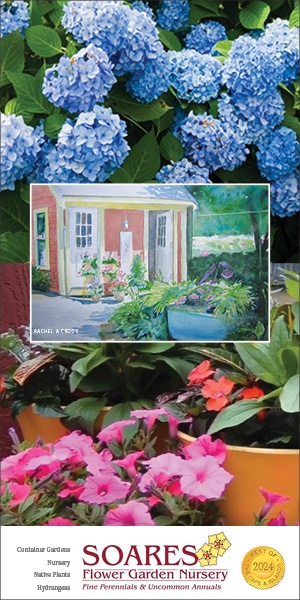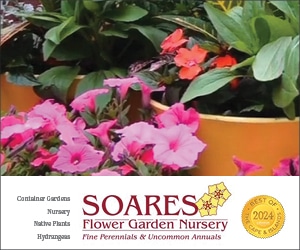
Reap What You Sow
Cape Cod Life / April 2012 / Food & Dining, Home, Garden & Design, Nature, Recreation & Activities
Writer: Susan Dewey
Reap What You Sow

Cape Cod Life / April 2012 / Food & Dining, Home, Garden & Design, Nature, Recreation & Activities
Writer: Susan Dewey
Starting your own vegetables from seed is time consuming—but worth the work—for Cape Cod gardens

Photo by Girl In Gear Studio
The pleasure of vegetable gardening never grows old. Even on Cape Cod—where variable soil conditions range from sandy to solid clay, and erratic weather patterns run from humid summers to cold, storm-battered autumns—there’s nothing like growing your own tomatoes, beans, brussels sprouts, lettuce, or whatever vegetable suits your fancy.
The gardening season on Cape Cod and the Islands is longer than in many other New England regions. The surrounding ocean warms things up every summer, which is why this area has a hardiness designation of Zone 7. Zone 7 stretches from Cape Cod to Georgia and includes places like Charlotte, North Carolina.
There are gardeners on the cooler Cape Cod Bay side who sometimes say their hardiness zone is Zone 6 (anyone who swims on both sides of this sand bar knows that the ocean side is way more balmy because the Gulf Stream’s eddies warm our water). Still, gardeners all over Cape Cod are much more fortunate than those in much of New England, where hardiness areas can dip down to Zone 4.
Much of my gardening life was spent in Zone 5, in a suburb of Worcester known for its extremely rocky soil. In Grafton, a town known as Hassanamesit (or “Land of Small Stones”) by the Nipmuc Indians, it was hard to dig more than a foot in any direction without hitting a rock or two. I despaired when I tried to dig my first vegetable garden in Grafton, knowing I had to add compost to rock-free, healthy soil for vegetables to flourish in Central New England’s short growing season. Grafton’s soil, however, was black gold compared to Cape Cod soil.
On our Centerville property, which is comprised mostly of old farm land, the soil is actually quite good for growing vegetables, especially on Cape Cod. There is at least 10-12 inches of loamy top soil, perhaps because the land around our old house has benefited from eons of decomposing plant material. Still, when we had a new septic system put in several years ago, I saw that the good soil lies atop pure sand, which is great for drainage, but tough for soil’s all-important water retention.

Optimal soil clumps easily with enough organic matter to hold some water, and also encourages all-important natural soil-building activities to occur, encouraging the growth of beneficial organisms like earthworms, good fungus, and other flora and fauna that create healthy soil conditions.
When we dug our first Cape Cod vegetable garden several years ago, we added a good 6 to 8 inches of compost, purchased by the yard from a local supplier. (A yard is 27 cubic feet.) You can also buy compost by the bag from local garden centers like Country Garden in Hyannis—there are lots of good varieties, but our favorites are the completely organic varieties made in New England.
Compost is crucial for successful gardening on Cape Cod, whether your soil is a little light and sandy like our Centerville soil, or wet and full of clay like the soil on my son’s land, just one town over in West Barnstable. He had to laboriously pick, hoe and double dig his vegetable garden in unforgiving muck and then add reams of compost.
I only added a few inches of compost to my soil last year, a mistake I lived to regret, compounded by the fact that I made a second classic gardening mistake—I settled for inferior seedlings from area big box stores, not wanting to take the time to start my plants from seed under grow lights for eventual hardening off and then transplanting outside. It was a mistake I lived to regret in mid- to late summer when my plants refused to adequately flourish and fruit, sometimes even falling victim to nasty diseases like the dreaded Late Tomato Blight.
Situations like this are probably what prompted the famous American gardener, Thomas Jefferson, to say late in his life, “I am an old man, but a young gardener.” The truth is that you never stop learning when you are a gardener, which is one of the reasons I endure all kinds of disappointments and failures when I garden. In this case, I learned from a much younger gardener.
Last winter, my son stubbornly stuck to his plan of starting all his plants from seed, building a long wooden table in his basement and installing fluorescent glass lighting just a few inches above his seed pots. I sniffed a little as I purchased pots of 3- to 4-inch tomatoes, brussels sprouts, cucumbers and zucchini. My plants were in the ground weeks before his and I couldn’t imagine that his spindly little seedlings would ever catch up to my mass-produced magnificence.

Of course, here’s where the moral of the story comes in—by mid-summer, my son’s peppers, eggplants, several kinds of tomatoes, squash, broccoli, and lots of interesting herbs were big and bushy tailed, while my flash-in-the-pan plants began to languish.
My peppers never fruited, the broccoli bolted early, and my tomatoes—my carefully watered, fertilized, and trained “Big Girls” and “Better Boys”—developed Late Tomato Blight, an insidious fungal disease that kills all the leaves on your tomato plants, leaving sad clumps of ripening fruit naked on the vine.
I finally had to face the fact that vegetable gardening, like anything else in life, is garbage in, garbage out. Faced with the bounty exploding from my son’s West Barnstable bog, I had to admit that good gardeners are patient, discerning, and flexible.
Good gardeners carefully plant biodegradable peat pots with infinitesimal lettuce seeds no bigger than your pinky fingernail, place the pots under cozy grow lights on their kitchen counters or in the basement. They scour the racks of local nurseries for heirloom seeds, buy potting soil that is the right fine mixture of all natural elements, and by July, their vegetables are gracing not only their own tables, but the shelves of local markets because the amazing bounty can’t be consumed by just one family.
As I write this, it is early February. On a tour of the perennial garden yesterday morning, I was delighted by the sight of daffodils pushing impatient green thumbs out of the still frozen Cape soil. In the vegetable garden, we still have kale and brussels sprouts, two vegetables that I seem to have no trouble growing, probably because they are very tough and can withstand impatient gardeners who want immediate gratification.
But you can bet that in a week or two, I will be searching our local nursery for top-quality seeds. I will carefully fill a plastic bag with sterilized potting soil, dampened with fine mist from a spray bottle. I will plant the lettuce, tomatoes, cucumbers, broccoli, squash and peppers at three times each seed’s diameter, gently scatter a fine layer of soil, cover the entire tray with Saran wrap vented here and there to avoid excess moisture retention, and place the infants under grow lights positioned just three inches above each tray. For 10 well-lit hours each day, I will let nature take its course, having learned from a pro how to be a forever young gardener.




